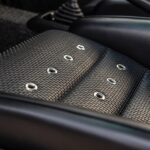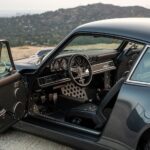The Porsche 911…… Few if any other car models can claim such an iconic and recognizable body line. Purists have dared call it perfection. Stream line hood, transitioning up the windscreen only to drop into a sloping rear. Cutting through the air like a knife through butter. The design has stood the test of time. Since 1964 the 911 is as easily as recognizable today as it was then. Radical redesigning would only serve to ruin the impeccable curves. However, one company have had the nerve to do just that. It’s dangerous to tamper with a masterpiece. Just as few would even think about attempting to remake iconic songs works by the likes of Michael Jackson or Whitney Houston. To have the gumption to take on the Porsche 911…….you’ve really got some nerve. To take on this kind of challenge takes more than bravado. You better be the best of the best. Otherwise, you are doomed to failure, only to have your name spoken as a joke, or worst yet – a cruel internet meme. Enter onto the stage Singer Vehicle Design. Founded by a former rock musician, Singer had one singular burning question……what if. What if – Porsche had today’s technology of aerodynamics. What if – Porsche knew the mathematical geometries required to attain the top speeds of Nürburgring. What if – Porsche had access to modern design materials and techniques. What if………. a question of the ages. Most only dream of a question like this, let alone dare to take on the challenge. Thankfully Singer succeeded where others have failed!
So you may be asking yourself, “if the 911 is as near perfection as they say it is, how are they going to improve on it?”. To answer this let’s first start at the beginning with the bones of the entire project. Singer starts with a donor 911 produced between 1989 and 1994. More specifically this is referred to as the 964. Naturally aspirated, air cooled, integrated bumpers, and the last model with more upright headlight assemblies, the model is extremely distinctive.
Once the donor has been submitted to Singer the tear down process begins. The vehicle is completely disassembled in order for the unibody structure to be completely media blasted, strengthened via welding, and finally given a full rust preventative treatment. Aside from the unibody, the doors (and sometimes the roof), everything else on the body is replace with an artistry of carbon fiber. The replacement components have carefully been designed to subtly alter the original dimensions, providing a wider, more aggressive, and overall lighter body.
Next, the engine is completely torn apart and built again with surgical precision. Customers have a choice between 3 different build plans based on their own lust for the awesome sauce and limitations of their wallet. No engine build is complete without being paired to an equally impressive transmission. For that reason, Singer provides another 3 choices customized for the purpose of how the owner intends to drive the newly born beast. Finally, (at least in terms of the power plant) a custom designed exhaust system is mounted to trumpet the fine notes of acceleration through the still air.
Now the fun part – all the look good pieces. Colors, patterns, materials, etc are limited only by your budget. Singer vehicles are bespoke master pieces so the partnership between owner and the design team is critical in reaching the finish line. Additional carbon fiber, brushed nickel, and leather accent the cockpit to create a sophisticated and not overly done seating area. One of my favorite signature pieces of a Singer is the woven leather seats intricately laced from an unlimited array of colors and textures. So distinctive and oh so perfect.
Singer literally leaves no bolt left unturned in it’s restoration and reinvention of the 911 but the result may just be the ultimate automotive driving machine. With a waiting list almost as long as the price tag, a Singer Porsche won’t be something you see very often. If you do, grab a selfie because you are in the presence of something special!














